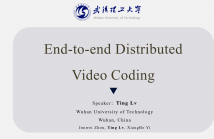
Block-based compressive imaging enables new video acquisition methodology while reducing raw data size, theoretically eliminating the need for complex coding algorithms. When transmitting raw data, however, the redundancy associated with random projection remains. This paper takes a fresh look at raw data structure by viewing it as cube made up of multiple downsampled images rather than a vector. As a result, we can view each individual data point as a pixel, allowing us to code more flexibly and versatility than state-of-the-art works.
- Categories:
 46 Views
46 Views

- Read more about Rate Distortion Characteristic Modeling for Neural Image Compression
- Log in to post comments
- Categories:
 27 Views
27 Views
- Read more about Fast Partition Mode Decision via a Plug-in Fully Connected Network for Video Coding
- Log in to post comments
FCN-Pre.pdf
- Categories:
 27 Views
27 Views
- Read more about Hyperspectral remote sensing data compression with neural networks
- Log in to post comments
We propose a novel approach to compress hyperspectral remote sensing images using convo- lutional neural networks, aimed at producing compression results competitive with common lossy compression standards such as JPEG 2000 and CCSDS 122.1-B-1 with a system far less complex than equivalent neural-network codecs used for natural images. Our method consists of a collection of smaller networks which compress the image band-by-band taking advantage of the very high similarity between bands on certain intervals.
- Categories:
 147 Views
147 Views
- Read more about Interpretable Learned Image Compression: A Frequency Transform Decomposition Perspective
- 1 comment
- Log in to post comments
Image compression is a key problem in this age of information explosion. With the help of machine learning, recent studies have shown that learning-based image compression methods tend to surpass traditional codecs. Image compression can be split into three steps: transform, quantization, and entropy estimation.
- Categories:
 62 Views
62 Views


- Read more about Learning-Based Fast Depth Inter Coding for 3D-HEVC via XGBoost
- Log in to post comments
The 3D extension of High Efficiency Video Coding (3D-HEVC) achieves excellent performance for 3D video coding while possessing significant computational complexity. To accelerate the time-consuming coding process of the depth map, a fast algorithm via XGBoost is proposed in this paper. Specifically, a total of 14 specialized XGBoost models are used for different block sizes and viewpoint types to achieve early coding unit partition determination (ECP) and early prediction unit mode selection (EPM) to avoid executing the exhaustive traversal coding process.
- Categories:
 90 Views
90 Views
- Read more about SAQENet: A Quality Enhancement Network for Compressed Video with Self-attention
- Log in to post comments
- Categories:
 13 Views
13 Views